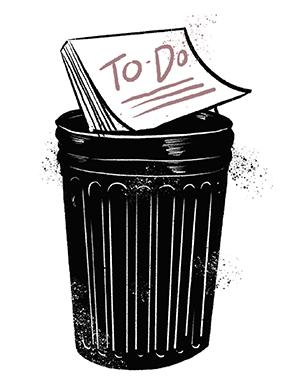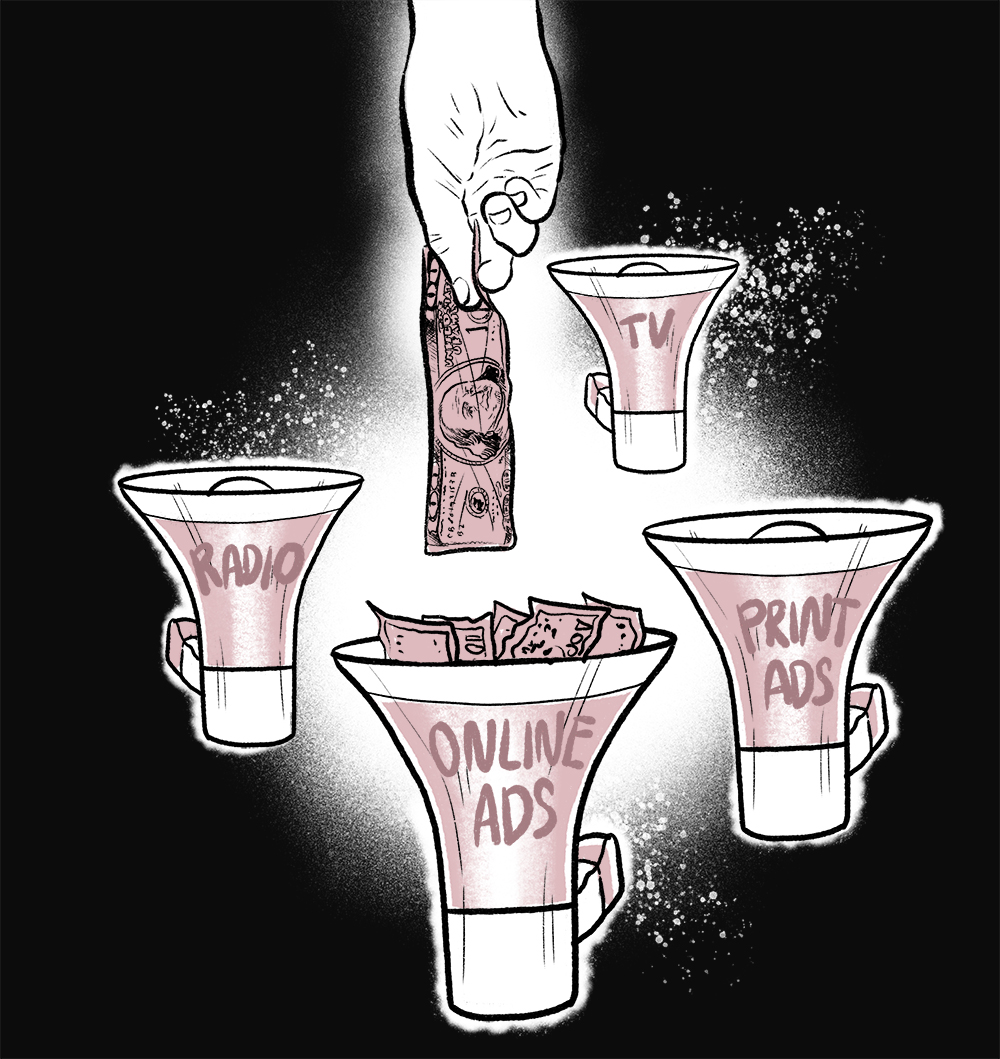ONE OF THE defining features of the American business model is a relentless impulse to add more — more bells, more whistles, more choice, more services, more hours, more convenience, more everything! The goal of all this is again — more… More sales, more profit, more growth and greater success! In our personal lives, it is no different. We’ve been taught that if we want more money, achievement, energy and happiness, we need to do more, work more, acquire more, add more to our bulging to-do lists.
But what if that’s wrong? What if the answer to getting what we want isn’t addition at all but subtraction? What if it turned out we didn’t even need “more” — that less is often simply the better option?
For a lot of business owners, this was one of the surprising lessons of the pandemic: they could get by just fine with less. Often, they had no choice but to cut down on business hours, shed staff, reduce advertising dollars, and streamline operations. And the result was that they still made the same or even more money, only in a less stressful, less hurried way.
Ardmore Eyecare in Ardmore, PA, exemplifies this shift. “Since returning to the office ‘post-pandemic’ if you will, our schedule and the way we see patients has changed,” shares optical manager Sherry Berry. “We moved to a four-day work week. Our schedule is constantly fully booked with 30 minutes dedicated to each patient. Anyone who would like to purchase eyewear, have adjustments, repairs, etc. must schedule an appointment with the optician. This has resulted in more time for one-on-one interactions. We do more with less now and it’s never been better.”
The idea of pursuing improvement or attaining a higher state by subtracting things is ancient. It’s fundamental to art and design (whitespace), music (“the space between notes,” as Debussy said), science (where the elegant theory holds supreme), wisdom (it’s what’s left when you distil knowledge), religion (finding moral purity in austerity), and yes, to frame vendor management; less is so often more.
It most likely holds true in your own business experience, too. Throw yourself at every opportunity and you end up doing run-of-the-mill stuff, and poorly. The benefits of eliminating all but the essentials are clarity, focus, energy, and often, beauty.
But as fundamental as this idea of less is more is, it seems to be one of those things we need to keep learning. Partly this is because we humans appear hard- and soft-wired to accumulate, hoard and add. MRI scans show different parts of the brain light up when we consider addition or subtraction. They are not part of the same calculation. According to Leidy Klotz, author of Subtract: The Untapped Science Of Less, when confronted with a problem we instinctively look to add something. The idea of enlargement, he says, is associated with progress and success. Eliminating something is rarely considered as the first option, or even the sixth.
Moreover, subtraction, especially the best kind that results in elegant solutions, often requires more work than adding. Oliver Wendell Holmes famously said, “I would not give a fig for the simplicity on this side of complexity, but I would give my life for the simplicity on the other side.” He was exalting the unadorned expression of essence — but that which was arrived at after digging to the very core of the matter. Former Apple chief designer Jonny Ive has spoken of delving into every part of the engineering and manufacturing process to come up with a laptop design that doesn’t need screws.
Advertisement
We humans tend to complicate things unless we make an effort not to. But when we do make that effort, the rewards can be sublime. Think of the Vietnam Veterans’ Memorial. Or, Ikebana, the Japanese Zen art representing the beauty of emptiness.
Matthew May, an innovation consultant who has worked with a range of companies from Toyota to Microsoft and is the author of The Laws Of Subtraction: 6 Simple Rules For Winning In The Age Of Excess Everything, says his message to his corporate clients covers three key principles that can be applied in any organization: what isn’t there often trumps what is; the simplest rules create the most effective experience; and limiting information engages the imagination.
“(By subtracting) you can cut through the noise and confusion of a chaotic world so that even the most complex things make more sense. You can draw and direct attention to what matters most so that your products and services have more meaning for others. You can focus energy and make your strategy more effective,” he says.
To be sure, there are times, says Klotz, when the best approach to a design, innovation or business issue is to add something. Subtraction is not always better but it’s overlooked for cultural and biological reasons or simply because addition exerts less of a cognitive load.
If you’re looking for a theme in 2022, perhaps “less is more” could be it. Certainly, the historical moment seems to call for it. In a widely read essay published by Medium, the writer and director Julio Vincent Gambuto sums up what’s at stake nicely:
“At no other time, ever in our lives, have we gotten the opportunity to see what would happen if the world simply stopped. [So] think deeply about what you want to put back into your life. This is our chance to define a new version of normal, a rare and truly sacred (yes, sacred) opportunity to get rid of the bullshit and to only bring back what works for us, what makes our lives richer, what makes our kids happier, what makes us truly proud. We get to Marie Kondo the shit out of it all.”
In the pages that follow, we share the ideas and thoughts we’ve gleaned from ECPs, industry consultants, our own reading of business best sellers and the odd scholarly article to identify 23 areas where you could do a little less… But be so much more.

1. climb the right mountain
We’ve all heard about the Pareto Principle, the 80/20 rule that 20 percent of an activity produces 80 percent of the desired results. This suggests you should aim to spend 80 percent of your time on the 20 percent of your activities responsible for delivering the bulk of your income. The hardest part of this advice for most is working out what not to do, because even deeply meaningful activities and productive work can be distractions and time-sinks if they are not the work that matters. That’s the logic behind a suggestion attributed to Warren Buffett: first, write down your top 25 goals; then identify the most important five, focus on them, and avoid the other 20 like the plague — they’re the seductive ones most likely to distract you precisely because they do matter. They just don’t matter most. Correct and timely billing is an important task, but does it need to be done by you? Dr. Marc Ullman of Academy Vision in Pine Beach, NJ, didn’t think so. “We just hired a company that is doing our billing in the background through our EMR and it is keeping me caught up and improving my cash flow.”
2. Do Even Less
The Underachiever’s Manifesto doesn’t sound like a book you’d find on the shelves of the ambitious business owner. But it should be. Written by a doctor named Ray Bennett it advocates a path to a superior kind of achievement based on the idea that you need to leave some slack in your life to take advantage of the serendipity of the world, and to give yourself the elbow room you need to excel. On this point, he quotes that Spanish underachiever Pablo Picasso: “You must always work not just within, but below your means. If you can handle three elements, handle only two… In that way, the ones you do handle, you handle with more ease, more mastery, and you create a feeling of strength in reserve.”
3. To-Do or Not To-Do
 A similar logic applies to your daily to-do list. Either use a system that stores all your to-dos out of sight and out of mind, other than a tiny handful you’re working on now (such as the “personal kanban”) or toss it. In Secrets Of Productive People, Mark Forster argues for the latter. Most people’s to-do lists are nothing more than wish lists. Worse, they use them to avoid doing the important things. It’s still procrastination, he points out, to do a lot of pointless tasks just because it feels nice to cross them off the list, while the big, difficult thing — the one that matters — goes undone. His alternative: On a piece of paper, write down only the five most important tasks you can think of. Then do them, in order, crossing them off as you go. (If you stop before completing one, add it again at the end.) Once the list is only two items long, add three more, to bring the total back to five. Then repeat. The point is that you’re regularly required to ask what really needs doing, since there are only five slots.
A similar logic applies to your daily to-do list. Either use a system that stores all your to-dos out of sight and out of mind, other than a tiny handful you’re working on now (such as the “personal kanban”) or toss it. In Secrets Of Productive People, Mark Forster argues for the latter. Most people’s to-do lists are nothing more than wish lists. Worse, they use them to avoid doing the important things. It’s still procrastination, he points out, to do a lot of pointless tasks just because it feels nice to cross them off the list, while the big, difficult thing — the one that matters — goes undone. His alternative: On a piece of paper, write down only the five most important tasks you can think of. Then do them, in order, crossing them off as you go. (If you stop before completing one, add it again at the end.) Once the list is only two items long, add three more, to bring the total back to five. Then repeat. The point is that you’re regularly required to ask what really needs doing, since there are only five slots.
4. Say no
Just say no. There is no middle ground here. This is one of the most important disciplines you can develop to ensure you stay focused on what’s important in your pursuit of a minimal — and sane — life. It helps to keep in mind that whenever you say “yes,” you’re also saying “no” to something else in regard to your objectives and goals. In life, every single thing involves trade-offs. As Greg McKeown points out in his book Essentialism: The Disciplined Pursuit Of Less, questions such as, “How can I fit everything I want to do into my schedule?” are fundamentally dishonest: they’re based on the false premise that trade-offs are avoidable. For the over-busy person, McKeown suggests his “90% Rule” — when considering an option, ask: does it score at least 9/10 on some relevant criterion?
5. Morning Hours
A similar philosophy informs the book Two Awesome Hours by Josh Davis. director of research at the NeuroLeadership Institute. The book rejects the premise that it’s worth trying to squeeze value from every moment of every day. Davis proposes fighting hard to ringfence one two-hour period of distraction-free work each day, at a time of peak energy — during which you’ll probably get more meaningful stuff done than in two whole days at half-power. There is a corollary of this: Schedule admin for when you don’t have energy for focused work. This a philosophy practiced IRL by the good folks at Pend Oreille Vision Care in Sandpoint, ID, according to Jen Heller, business manager: “At one of our locations, we cut staffing down from all week to just two days — those two days are super busy but it has freed up time for management and staff to tackle other projects.”
6. Do Nothing
 “Doing nothing isn’t an option.” Oh, yes, it is. And it’s often the best one, says Jason Fried, the co-founder of software company Basecamp in his anti “cult of work” manifesto It Doesn’t Have To Be Crazy At Work. “‘Nothing’ should always be on the table. Change makes things worse all the time. It’s easier to f*ck up something that’s working well than it is to genuinely improve it. But we commonly delude ourselves into thinking that more time, more investment, more attention is always going to win,” he writes. “That’s why rather than jumping on every new idea right away, we make every idea wait a while. Generally a few weeks, at least. That’s just enough time either to forget about it completely or to realize you can’t stop thinking about it.”
“Doing nothing isn’t an option.” Oh, yes, it is. And it’s often the best one, says Jason Fried, the co-founder of software company Basecamp in his anti “cult of work” manifesto It Doesn’t Have To Be Crazy At Work. “‘Nothing’ should always be on the table. Change makes things worse all the time. It’s easier to f*ck up something that’s working well than it is to genuinely improve it. But we commonly delude ourselves into thinking that more time, more investment, more attention is always going to win,” he writes. “That’s why rather than jumping on every new idea right away, we make every idea wait a while. Generally a few weeks, at least. That’s just enough time either to forget about it completely or to realize you can’t stop thinking about it.”
7. Efficient vERSUS Effective
When it comes to creativity, a reverse logic applies. Doing things more “efficiently” in a superficial sense means doing them worse. There’s evidence that we need to daydream; perhaps we also need those moments of afternoon lassitude and aimless backroom conversations. Creative work depends on a kind of inefficiency. Breakthroughs depend on being stumped and feeling frustrated. In Creativity Rules: Get Ideas Out Of Your Head And Into The Real World, Tina Seli urges you to bask in your problem for a while. If you go straight to the solution, you will likely end up thinking too narrowly. If you frame wider, you might come up with a creative answer. “Living in that problem space and falling in love with your problems is one of the most powerful ways to unlock really innovative solutions,” she says.

8. Let Bad Things Happen
Many business owners and managers fall into the category known as overfunctioners. Faced with a challenge — an employee who is not doing a task properly or a request for help — they immediately jump in and do it themselves. It’s an approach that is not only tiring but reinforces the expectant or helpless behavior of customers and staff. Don’t assume that because someone else wants something done, it needs doing, says the law professor Elizabeth Emens in her book The Art Of Life Admin. Learn to use strategic delay (some things sort themselves out), and train employees and family to recognize when a version of “Google it yourself!” is the answer to their question. Such an approach means potentially letting small bad things happen and tolerating the resulting anxiety. To quote the psychologist Carin Rubenstein, overfunctioners need a new motto: “Be less than you can be!”

9. Ask Questions
How do I know what to subtract? Ask someone, says Matthew May, author of The Laws Of Subtraction: 6 Simple Rules For Winning In The Age Of Excess Everything. Something like, “What’s the one or two things you’d love me to remove or eliminate or stop doing?” They’ll usually have a surprising number of suggestions, he says. Productivity blogger Tim Ferriss has a favorite question when confronted with a problem: What would this look like if it were easy? Once you have answers, May recommends running quick tests under a system he labels “enlightened trial and error.” The team at Spring Hill Eyecare in Spring Hill, TN, have informally formalized this process in something they call a Hackathon. Shares optical manager Amie Robinson, “We get the whole team together and give them an hour to brainstorm on ideas to help patient flow, processing orders, everything. You’d be surprised how much insight you can gain from this activity.”
10. Ask “Extreme Questions”
Ferriss advocates taking this approach to an extreme as a “forcing function.” In an essay 17 Questions That Changed My Life, he writes: “The question I found most helpful was, ‘If I could only work two hours per week on my business, what would I do?’ Honestly speaking, it was more like, ‘Yes, I know it’s impossible, but if I had a gun to my head or contracted some horrible disease, and I had to limit work to two hours per week, what would I do to keep things afloat?’” Confronted with such a constraint, you may be surprised at the ideas you, or your team in Spring Hill Eyecare’s case, come up with.
Advertisement
11. Limit Your Capacity
The Jevons Paradox explains how traffic doesn’t improve even when you build a 24-lane highway. Make something more efficient, and more people will use it. Less obviously, the same rule applies to work: Prove you get things done quickly and more will be asked of you.
The rule of thumb is just because your problem is one of strained capacity, don’t assume increasing capacity is the answer. It may make more sense to reduce, or at least put a ceiling on, your capacity instead. Resolve to process email for a certain period each day, rather than trying to answer it all, and you’ll moderate the incoming flow — promptly answered email only ever spurs more email. The same thing applies to customer expectations. Always respond to a customer within two hours and that becomes the minimum a customer or business partner will tolerate. As the old chestnut goes: under promise and over deliver. Think a job will take five days? Tell the customer seven and deliver on the sixth. Their surprise and gratitude will be genuine.
Here’s an example from Kim Hilgers, optical manager at Akre & Clark Eyecare in New Ulm, MN: “I eliminated the ‘substitution’ parts program they used to have here. Opticians would spend up to half an hour looking for a free frame part or parts for people who broke their glasses and no longer had a warranty. They never charged anything and patients rarely seemed grateful. Now we look for a new frame for their lenses but charge them the regular retail price. No complaints from the patients and happier opticians. Win win!”

12. Focus on the negative
Says May: At the heart of every challenge or business decision lie three tough choices: What to pursue versus what to ignore; what to leave in versus what to leave out; and what to do versus what not to do. “If you focus on the second half of each choice — what to ignore, what to leave out, what not to do — the decision becomes exponentially simpler. The key is to remove the extraneous stuff — anything obviously excessive, confusing, wasteful, hard to use or ugly,” he writes in The Laws Of Subtraction.
“When you remove just the right thing in just the right way, something great is bound to happen.” Optician Carissa Dunphy of Monroe Vision Clinic in Monroe, WA offers an easy suggestion: “If something is a time waster then take the time, once and for all, to fix what is wrong so you never have to waste that time again. This could be anything in the office … Printing the same thing over and over? Laminate it. Calculating the same thing over and over? Make a form or spreadsheet that does it for you.
Entering orders or patient workup data in three different places? Find the way to enter it once! Quit wasting the same on repetitive tasks.”
13. More limits
Working fewer hours is obviously great for families, friendships, hobbies and the spirit. But the most interesting implication of recent research is that it appears to be good for productivity and work quality, too. The brain needs to rest to operate well.
Meanwhile, fixed shorter hours provide a useful sense of constraint: knowing you’ve got to squeeze everything into fewer days seems to improve efficiency overall. In 2016’s Deep Work, Cal Newport advocates this approach via “fixed-schedule productivity” — that is setting certain periods for intense important work during a day, applying a short transition period or ritual to mark the end of the workday and then completely stopping, say at 5pm. In the early aughts, Boston Consulting Group mandated one night off a week for its workaholic consultants. Internal surveys showed it produced a more effective and efficient staff who stayed with the company longer. Dr. Texas L. Smith of Dr. Texas L. Smith & Associates in Citrus Heights, CA is on board with this philosophy. “Several months ago my office went to a four-day work week and all salaries stayed the same. I see patients three days a week and the extra day is catch up time for opticians and assistants.”
14. Fewer Rules
Too often, managers assume the key to improvement must be more procedures and standards. But the experience that results for customers is often infuriating as they are met by, say, service reps who refuse to be flexible. The secret is to create policies for the many, not the few. That allows you to design policies to bring out the best in people, not micromanage their every move or bind them in red tape. Netflix claims to have no vacation policy, leaving it up to staff to track and decide. Electronics chain BestBuy adopted a “results-only work environment,” in which staff could work where and when they liked, so long as their jobs got done. In short, the idea is that less bureaucracy + trust = more creativity. As a rule of thumb, “the simplest rules create the most effective experience,” says May. Optician Caitlin Wicka of 1 Hour Eye Docs in Montrose, CO, will be gratified by the company she is in. “We used to be a lot stricter at the office but it never made it run more efficiently and we had to change with the times to keep employees. Now, we don’t really say no to time off and work short a lot of time. Because of that, however, to retain people, we have had to become more lax on rules and policy.”

15. Fewer Worker Bees
The Peter Principle states that in hierarchies, people “rise to their level of incompetence.” Do your job well, and you’re rewarded with promotion, until you reach a job you’re less good at, where you remain. Over time, a business’s overall talent levels deteriorate. No one person need be peculiarly crappy for this to occur; organizations just tend to be crappier than the sum of their parts. GE’s Jack Welch’s answer was to regularly prune the bottom 10% of his employees. It’s harsh, but you maintain high standards and you may find you ultimately need fewer workers. Optician Rick Rickgauer of Vision Associates in Girard, PA, summarizes this beautifully: “The most efficiently run businesses all have one thing in common. Great employees.”
16. Fewer Customers
It is not only employees that need regular evaluation and subtraction, but also customers. Be willing to fire those that are a drain on your resources, says Anthony K. Tjan. Writing in the Harvard Business Review he recommends regularly subtracting the least valuable 5% of your customer base. “It is a fallacy that you need to keep all your customers because many of the small customers will become large ones,” he says. In fact, he argues, you’re likely to find a stubbornly consistent 5% of your customers who buy in small volumes and require higher maintenance as a cohort than other groups. “You want to give the most time, energy, and service to those who will provide the greatest long-term reward and loyalty.” Ferriss concurs but goes further, suggesting you try to find a way to put the bulk of your ordinary customers on autopilot with simple terms and standardized order processes and then focus on “deepening relationships (and increasing order sizes) with your three-to-five highest-profit, lowest-headache customers. Mallory Haun, optical lab manager of MetroSpecs Optical Shop in Fayetteville, NC, presents her practice’s elegant solution: “We only offer premium lenses to our clients. We price at one price block, including AR, scratch resistant, and blue block filters on all lenses; the only add on is Transitions. This streamlines the choices and customers receive top quality vision. The less decisions they need to make the happier they are and the quicker the process. Then we can focus on the fun of choosing the frame style and colors and celebrate the purchase.”
17. Minimal Sales #1
The conventional wisdom says a good sales pitch is built on three main points, based on the thought the customers can’t keep more than three ideas in their head at one time. Tjan says to strip your story down to one core idea. “While I have always been taught to pitch or do presentations around three key points, it is easy to slip into focusing on three supporting points and lose the overarching big idea. Even worse, is trying to pitch three distinct ideas, he says. “A simple story that repeats a consistent theme is better than a truckload of documents and demos. Subtract and seduce around a single idea,” he says.
Advertisement
18. Minimal Sales #2
Use half as many words and they’ll hit twice as hard. Every writer knows it. Salespeople need to learn it. When you talk too much you come across as anxious and nervous or defensive and combative. “Selling is a transfer of confidence. The seller must transfer his or her confidence in the product to the buyer. When you babble, you don’t sound confident,” says Roy H. Williams, author of the bestselling Wizard Of Ads. “Always answer questions as asked. This means that you should focus your energies on providing the simplest answer in the fewest words. If your customer wants to know more, they’ll ask you a follow-up question.”
19. Fewer Meetings
Meetings have a bad rap as a time trap — and often it’s justified. They proceed at the pace of either the slowest participant or the need of the manager to hold center stage. According to studies, executives find at least half of all meetings unproductive. Jim Buckmaster, CEO of Craigslist, has a simple policy: “No meetings, ever.” But if you’re a business owner or manager, you’re probably already thinking of reasons why you couldn’t do the same. Perhaps then you can strive for fewer and better. The key question for distinguishing a worthwhile meeting from a worthless one is this: is it a “status-report” meeting, designed for employees to tell each other things? If so, it’s probably better handled via email or the bulletin board in the backroom. That leaves a minority of “good” meetings, whose value lies in the coming together of minds, for example, such as a well-run brainstorming session. At Midwest Eye in Downers Grove, IL, they actually use meetings to become more efficient. “We have tried to minimize time spent on certain things, so we bring to meetings things that have been roadblocks to departments in order to ask all staff for ideas we can implement to help in those areas,” says practice manager Pam Peters.
20. Actually, Less Choice is Better
Most retailers believe the more choice the better. But studies show too many options can overwhelm the shopper and freeze decision-making. As NYU marketing professor Scott Galloway noted recently in his No Mercy/No Malice column, “consumers want less choice, but instead confidence in the (fewer) choices presented to them.” Eliminate pieces from your cases that are too close in price and style. “Aim to show customers no more than three quite different items at a time,” says sales trainer Shane Decker. Also, limit the number of vendors you buy from. With fewer suppliers to work with, you can establish a true partnership based on ensuring both parties do well. It’s also less time-consuming dealing with conflicting demands for how you display their goods and branding. Star Taylor, optical manager of Richens Eye Center in St. George, UT, is on board. “I am always looking for ways to simplify. I remove inventory that does not move and try something else in its place, not adding a line, but replacing it. We created a page that sums up our package options and keep them to “good, better, best” to try and limit options. We are very streamlined.”

21. Rein In Your Marketing
Ad Wizard Williams says small businesses need to be wary of what he calls “Fortune 500 concepts” and the most dangerous of these is the idea of a “media mix.” “The widespread belief about the value of a ‘media mix’ has caused small business owners to sprinkle their ad budgets across several different media because they are worried they are going to ‘miss’ someone. After all, ‘Not everyone listens to the radio.’ ‘Not everyone watches the news.’ ‘Not everyone looks at billboards.’ ‘Not everyone blah, blah, blah.’
“Advertiser, you can’t afford to reach everyone. You’ve got to choose who to lose.
“Would you rather reach 100% of the people and convince them 10% of the way, or reach 10% of the people and convince them 100% of the way? Repetition is effective. Repetition is effective,” he says. He adds one caveat: You do need a budget for some online advertising, say 20%. “Google is the new phone book.”
22. Hide Your Phone
In the current age, nothing makes life feel as fragmented, rushed and overwhelming as digital technology, social media in particular. Thus the emergence in the last few years of the “digital minimalism” movement, which essentially involves demanding that any given device, app or online activity makes a major positive difference to your life before you allow it any time or attention. It now seems ridiculous that we swallowed Facebook’s line that more connection is always better. True connection, it’s becoming clear, depends on not trying to do it with too many people at once. “We hook up to email addresses and Slack channels and then just rock’n’roll with messages all day long … hoping busy-ness will transmute into value,” observes Cal Newport, whose book deep work makes the case that constant connectivity is disastrous for both job satisfaction and the bottom line.
23. Last, Few Words
Simplifying your life, subtracting the extraneous or finding the elegant solution to a problem are difficult and at times dispiriting because they imply that no, you can’t have it all. But it shouldn’t be. In fact, it’s liberating, says Oliver Burkeman, author of Four Thousand Weeks: Time Management For Mortals. Knowing you can’t get everything done spares you the anxiety of trying to figure out how to. To spend time or effort on anything is, by definition, to choose not to spend time or effort on an infinite number of alternatives. Declining to do something that seems worthwhile — say, learning how to trade stocks by charts and technical analysis — is a reaffirmation that doing the best job for your current customer matters more.